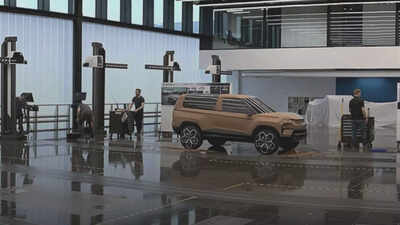ARTICLE AD BOX

The transformative power of automotive design.
The article is authored by Ajay Jain- Head of India Design Studio at Tata Motor.Design is often perceived as the art of creating visually pleasing concepts. However, in the automotive industry, it transcends mere visual appeal— it shapes materials into sophisticated, purposeful vehicles and translates complex technologies into intuitive, human-centric experiences. From enhancing vehicle safety and performance to embedding cutting-edge technology, design plays an instrumental role in shaping the industry’s future. In recent years, factors such as rapid digitisation, the rise of electric and connected vehicles, evolving regulatory frameworks, and increasing consumer demand for personalisation have placed
automotive design
at the forefront of industry transformation. Recent projections indicate that by 2030, the auto component industry is expected to triple in size to USD 200 billion and automotive design will be a key catalyst in enabling this growth. Most importantly, it reflects a brand’s core values—whether its sustainability, innovation, or heritage—ensuring a lasting impact in an ever-evolving market.
Driving multidimensional experiences through design
In the automotive industry, design is far more than just a differentiator—it is a strategic tool that shapes both the product and the brand. Designing an automobile demands a precise balance of science, art, and engineering. It involves selecting the right materials, shaping them into optimal forms, and refining the ‘touch and feel’ of a vehicle to create a memorable customer experience. Every design choice, whether in exterior styling, interior comfort, or the integration of intuitive controls, directly influences consumer perceptions and purchasing decisions.
Tata Sierra design explained: Glass panels but no safety compromises! | TOI Auto
To achieve this, automakers rely on cross-functional collaboration where design teams work alongside engineering, product development, manufacturing, and marketing departments. This synergy ensures that every vehicle combines technical precision with emotional appeal, ultimately shaping a distinct and enduring brand identity. The automotive design process involves various specialised roles, each contributing unique expertise. Shape designers define the exterior form through sketches and digital renderings, while space designers optimise interior layouts for comfort and functionality. Surface designers select materials, textures, and finishes to enhance the vehicle’s tactile and visual appeal, while interaction designers create intuitive controls that blend the latest technology with functional mechanics for safer and seamless user experiences.
Redefining the future of mobility
The
future of mobility
is driven by tech innovations and sustainability, reshaping automotive design and user experiences. As consumers increasingly expect granular personalisation with features like internet connectivity, embedded IoT devices, and advanced smart technologies, vehicles are evolving into mobile extensions of the digital ecosystem. Building on this transformation, the growing adoption of
autonomous driving technology
is prompting a fundamental re-evaluation of
vehicle architecture
. With self-driving capabilities reducing the need for driver-centric designs, automakers are shifting their focus to occupant-centric layouts, creating more flexible and experiential interiors.A major shift in automotive design is also witnessed by the rapid rise of electric vehicles (EVs). Unlike traditional internal combustion vehicles, EVs offer greater flexibility in layout due to the absence of large engines and complex drivetrains. This allows designers to prioritise spacious, modular interiors and experiment with aerodynamic, minimalist exteriors that enhance energy efficiency. Moreover, as the concept of sustainability takes centre stage for both consumers and brands, the use of eco-friendly materials, recycled components, and energy-efficient manufacturing processes is gaining momentum. With tightening environmental regulations and growing consumer awareness, automakers are increasingly embracing circular design practices to reduce waste and extend vehicle lifecycles.
Shaping the way forward
Automotive designers are no longer bound by traditional constraints—they are redefining vehicles as dynamic, multifunctional spaces. By leveraging AI, smart sensors, and adaptive systems, vehicles are being transformed into immersive environments that offer personalised comfort, entertainment, and productivity features. The convergence of technology and sustainable principles is enabling the creation of vehicles that forge deeper, more meaningful connections with consumers. Cars are evolving from mere modes of transportation into versatile, experience-driven platforms, reflecting a future where design, innovation, and sustainability are inseparably linked.Disclaimer: Views and opinions expressed in this article are solely those of the original author and do not represent any of The Times Group or its employees.



.png)
.png)
.png)
















 12 hours ago
4
12 hours ago
4









 English (US) ·
English (US) ·